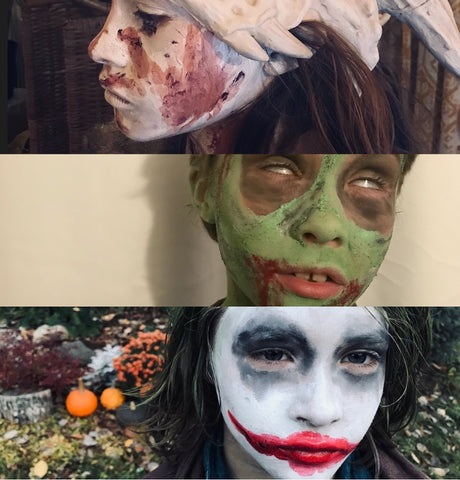Fantasy makeup

It's almost Halloween and you might want to use some makeup on yourself or your kids. According to a study published in the International Journal of Environmental Research and Public Health, synthetic makeup could represent a health risk. Same story from the newspaper The Medical Journal of Australia which highlights the presence of lead in certain makeup products. Since children will already gorge themselves on sweets, considered by some to be a demonic food (The Demon Sugar) worthy of Samhain (religious festival of the Gaelic year associated with Halloween), we thought of offering you more natural alternatives to commercial fantasy makeup, in order to minimize the effects on health and the environment of this oh-so-much festival adored by little ones, but also by many adults who love to dress up for the occasion.

But first, here are some historical notions about Halloween for our enjoyment. This festival celebrated on October 31 each year is inspired by the Celtic festival Samhain. The Celts believed that the day of Samhain, marked by the end of summer and the harvest, then by the beginning of winter and the cold and dark weather associated with death, opened the door between the world of the living and that of the dead. Evil spirits could then join the living, cause problems and damage crops. They could also communicate with the druids and transmit prophecies to them. Ceremonies therefore took place to pay homage to these spirits. Bonfires were lit and animal sacrifices were carried out by the Druids who wore costumes, often made of animal heads and skins.
The name of the holiday comes to us from Pope Gregory III (8th century) who designates the 1er November All Saints’ Day (“all healthy”). All Saints' Day being close to Samhain and October 31 being at the time known as All Hallows Eve, the event becomes Halloween and we wear costumes of ghosts, demons and monsters to deceive evil spirits and go unnoticed.
Although people originally dressed up as scary beings, it is now common to see all kinds of costumes requiring all kinds of makeup: skeleton, fairy, butterfly, animals, etc. These makeups can be done with more natural products for the health of the skin and the body in general since the products applied to the skin reach the blood circulation. Here are some tips for making your own makeup according to your budget, your needs and your personal tastes.
Coloring powders are essential: oxide of zinc for white, black iron oxides, brown, YELLOW, orange or red, blue ultramarines, pink Or purple, white clay, beige, yellow, red, grey or green, the micas for a shiny effect and certain plant powders such as indigo for blue or beet for pink. We advise you to test small quantities before launching into large formulas, to find what suits you.
For foundations, simply add coloring powders to a base cream to create foundations of all colors. It is best to make a thick base cream or use the natural hand & foot cream to cover well, but depending on the desired effect, you can also use a more fluid cream which will dry more quickly like the natural face cream. The amount of coloring powder to use will depend on the color you want. The clays will eventually dry and leave a cracked effect, which can be interesting for certain disguises. However, it is possible to add fatty substance to obtain a smoother foundation that will dry less quickly and will not dry out the skin.
We can make colored gels inspired by mascara recipes and eyeliner and add them with coloring powders, or by adding colorings in type formulas aqueous gel or oily gel, depending on the desired effect and sensation. Aqueous gels will dry on the skin while oily gels will stay on the surface longer with a shinier finish. For blood for example, we can combine the two types of gel with added red iron oxide to create both an illusion of fresh blood and dried blood.
Depending on the size of the line desired to create more precise lines, it will be possible to make pencils (thin line, hard makeup) or sticks in lip balm tubes (medium features, semi-hard makeup) by adding coloring powders of your choice. The basic recipes are the same as the recipes for the eye contour pencils and the lipstick.
To create texture, for example to create the illusion of wounds or dried blood, clays can be used in large quantities in creams or gels. The idea is to create a thick product that hardens on the skin. Clays are ideal for creating these kinds of special effects.
Here are some examples of makeup for Halloween with cream foundation, gel and stick makeup with added zinc oxide, black, brown and red iron oxides, green chrome oxide and green and gray clay.

References :
Hartel, R.W., Hartel, A., Hartel, R.W., & Hartel, A. (2014). The Demon Sugar. Candy Bites: The Science of Sweets, 21-24.
Morton, L. (2013). Trick or Treat: A History of Halloween. Reaktion Books, London, United Kingdom.
Porter, G. P., & Grills, N. J. (2013). The dark side to Halloween: Marketing unhealthy products to our children. The Medical Journal of Australia, 199(8), 528-529.
Salles, F. J., Paniz, F. P., Batista, B. L., Nardocci, A. C., & Olympio, K. P. K. (2022). Potentially Toxic Elements in Costume Cosmetics Used by Children and Adults Are Associated with Cancer Risk. International Journal of Environmental Research and Public Health, 20(1), 531.
Smith, H. (1996). Samhain: The Celtic Inspiration for Modern Halloween. https://brewminate.com/samhain-the-celtic-inspiration-for-modern-halloween/
- Myriam Leduc


